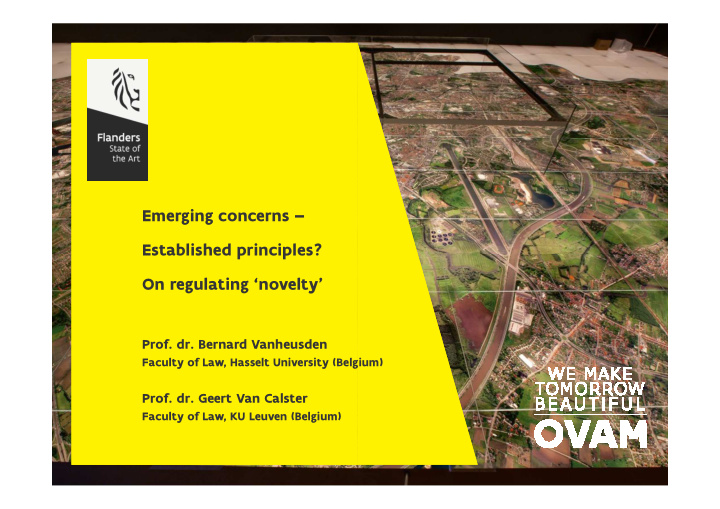



Emerging concerns – Established principles? On regulating ‘novelty’ Prof. dr. Bernard Vanheusden Faculty of Law, Hasselt University (Belgium) Prof. dr. Geert Van Calster Faculty of Law, KU Leuven (Belgium)
Introduction Two main questions: Do you have to regulate ‘novelty’? How could you regulate ‘novelty’?
Starting point: principles Article 191 TFEU Uncertainty / unknown risks � precautionary principle Certainty / known risks � prevention principle + trend towards making the precautionary approach part of customary international law
Precautionary principle No legally binding definition European Environment Agency (EEA, 2013): “The Precautionary principle provides justification for public policy and other actions in situations of scientific complexity, uncertainty and ignorance, where there may be a need to act in order to avoid, or reduce, potentially serious or irreversible threats to health and/or environment, using an appropriate strength of scientific evidence, and taking into account the pros and cons of action and inaction and their distribution”
Precautionary principle Key aspects Scientific uncertainty Can flow from insufficiency, inconclusiveness or imprecision ofstudies Potentially serious or irreversible? <-> European Court of Justice (ECJ): it is for the decision- maker to assess whether potential risks exceed the threshold of what is acceptable to society
Precautionary principle ! Science Identification of potentially negative effects + risk assessment/evaluation, as objective and complete as possible ! Inconsistency is to be expected from complexity Other constraints: general principles of risk management, such as: Proportionality Non-discrimination Cost-benefit analysis
Precautionary principle Obligation or permission to regulate (and adopt protective measures)? ECJ: permission (it expands rather than contracts the regulatory freedom) BUT: for example NGOs can use it to challenge national decisions and require action E.g. C-127/02 Waddenzee; on mechanical cockle fishing licenses � now banned)
Precautionary principle Burden of proof? Generally regulating authority needs to produce evidence of existence of potential risk However, prior autorisation of products is widespread (e.g. REACH) � burden of proof reversed, because of: Analogy from known hazards Novelty (low ‘knowledge/ignorance ratio’) …
Precautionary principle Case law: Most cases by manufacturers whose product has been excluded E.g. EU restrictions on use of certain neonicotiniod insecticides to protect bees � restrictions ok (T-429/13 and T-451/13) Sometimes country against continued use E.g. Sweden against herbicide paraquat � Commission’s decision annulled (T-229/04)
Precautionary principle Fear for ‘false positives’? EEA, Late lessons from early warnings , 2013: misplaced 88 cases identified to be alleged false positives � only 4 real false positives (US swine flu, saccharin, food irradiation and Southern leaf corn blight) Precautionary actions can stimulate innovation ! Take early warning signals seriously Research overly focuses on well-known rather than unknown hazards
Other (new) principles? Quid an innovation principle? European Risk Forum, 2015: “Whenever policy or regulatory decisions are under consideration the impact on innovation as a driver for jobs and growth should be assessed and addressed.” Capable of freezing the precautionary principle? Important to incorporate consumer and environmental safeguards and accept that innovation goes hand in hand with precaution K. Garnett, G. Van Calster and L. Reins, “Towards an innovation principle: an industry trump or shortening the odds on environmental protection?”, Law Innovation and Technology 2018, 1-14.
Other (new) principles? Quid the product choice principle (or substitution principle)? REACH Regulation, art. 55: “analyse the availability of alternatives and consider their risks, and the technical and economic feasibility of substitution.”
Potential instruments / ways to regulate? Ban/prohibition E.g. Stockholm Convention on POPs (2001) Restrict trade through PIC procedure E.g. Rotterdam Convention (1998) Prior autorisation E.g. REACH Regulation (2006)
Potential instruments / ways to regulate? Norms E.g. for soil; non-ionising radiation;… Use of permit procedure E.g. according to the Water Framework Directive (2000) priority substances have to be taken into account
Potential instruments / ways to regulate? When evidence of harm emerges: taxes and charges ~ polluter pays principle Role of life cycle assessments?
Potential instruments / ways to regulate? Enforcement / compliance Liabilty regimes Two main types of liabilty Fault liability Strict liability � expansion of scope?
Is our current legal framework fit for purpose? No (direct) EU soil regime Often hesitation for new legislation RISK: potentially 27 different regimes + courts start taking over (~GMOs) ~ high opportunity costs; e.g. during due diligence Thus: industry should see it as an opportunity and create support for EU framework
Recommend
More recommend